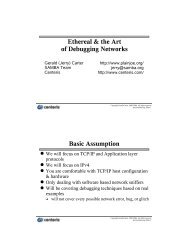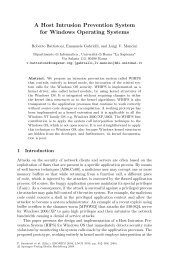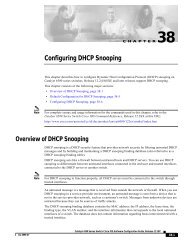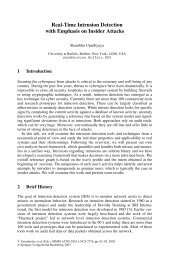Advanced Windows 2000 Rootkit Detection (Execution Path Analysis)
Advanced Windows 2000 Rootkit Detection (Execution Path Analysis)
Advanced Windows 2000 Rootkit Detection (Execution Path Analysis)
You also want an ePaper? Increase the reach of your titles
YUMPU automatically turns print PDFs into web optimized ePapers that Google loves.
It should also be noted, that popf/pushf are not the only instructions which are used to<br />
access EFLAGS register. Similar functionality we can also observe in the iret/int<br />
and few others instructions 2 , so that similar steps should be taken.<br />
EFLAGS protection has not been implemented yet, partly because we should be able to<br />
detect such tricks with pushf/popf instructions, by analyzing diffs of execution traces.<br />
However, this should be implemented in future releases.<br />
Attacks against specific tool<br />
If the attacker knows everything about the tool, which implements presented technique,<br />
she can cheat it in many ways. For example, she knows (or can find it very easily, using<br />
pattern searching for example) where, in kernel area, is stored counter variable, which is<br />
incremented by debug handler.<br />
Such attacks are expected to be implemented by rootkit authors, only when a specific tool<br />
will became quite popular. If we had got many tools implementing EPA (or many<br />
versions of one tool), such attack won’t be profitable for the attacker.<br />
However, we would like to be also resistant for such implementation based attacks.<br />
Probably the only way of doing it, is strong polymorphic code generator. After<br />
administrator has downloaded such tool into his system, during installation phase, a<br />
unique kernel driver and testing program should be generated.<br />
Polymorphic generator has not yet been implemented.<br />
Related Work<br />
As it has been said at the beginning, author is not aware of any other general approach to<br />
rootkit detection, which is not based only on memory scanning.<br />
It should be noted that presented technique is not very OS specific, and author has also<br />
implemented a similar detection utility on Linux system. See [5] for more details and<br />
very simple proof of concept code for Linux 2.4.<br />
References<br />
[1] Greg Hoglund, et al, ROOTKIT home, telnet://rootkit.com,<br />
[2] palmers, Sub proc_root Quando Sumus, Phrack Magazine, issue 58, 2001.<br />
[3] fuzen_op, fu rootkit, telnet://rootkit.com,<br />
[4] Holy Father, Hacker Defender Home, http://rootkit.host.sk,<br />
[5] Jan Rutkowski, <strong>Execution</strong> path analysis, Phrack Magazine, issue 59, 2002.<br />
[6] IA-32 Intel Architecture Software Developer’s Manual, vol1-3.<br />
2 The list of all instructions which interact with EFLAGS register can be obtained from [6].<br />
12









